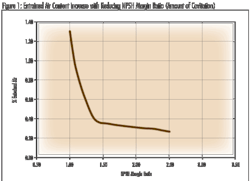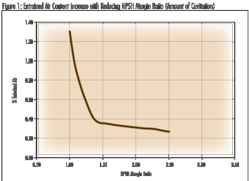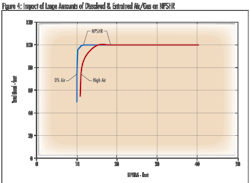By Allan R. Budris
In the June 2009 Pump Tips Column on cavitation and air in centrifugal pumps, the writer mainly concentrated on the positive impact of small amounts of entrained and/or dissolved air on pump reliability. However, there are potential negative effects from higher amounts of air/gas which will be expand on in this column.
Air or gas may enter a pump in high amounts by several means. Any leaks in the suction piping under vacuum conditions will introduce entrained air into the pumped liquid, such as through valve packing or pipe leaks. High concentrations of entrained gas in the liquid can also be created from decaying sewerage, and/or by coming out of solution as the pressure drops due to pipe friction losses and high velocities.
It should be noted that only the static head controls the flashing of the liquid (at or below the vapor pressure) and the amount of dissolved gas that remains in or comes out of solution. The static head is equal to the total head (which except for friction losses remains constant) minus the velocity head.
Air may also enter the suction piping through surface vortices at the sump intake. Table 1, from the Hydraulic Institute, lists the minimum submergence required to prevent air from being sucked into a piping intake.
Finally, entrained vapor will increase as dissolved air or gasses come out of solution in the eye of the impeller, as shown in Figure 1, due to lower pressures and the formation of cavitation bubbles in the impeller inlet region, especially as the suction pressure to the pump (NPSHA or NPSH Margin) is reduced. Cascading water, excess agitation and ice in a river in the spring can also increase the dissolved and entrained air content.
Negative Impacts of Entrained Air
The three major concerns from operating a centrifugal pump with excess entrained air are the impact on the head-capacity performance of a pump (lower head and flow, possibly leading to air binding and the complete loss of flow); the impact (increase) on the pump NPSHR (net positive suction head required); and/or dry running and possible failure of any internal sliding contact surfaces, such as the mechanical seal faces, wearing ring surfaces and any internal sleeve bearings (such as used in vertical turbine pumps, canned motor and magnetic drive pumps).
Entrained air, if it is too high, can have a large impact on pump performance, up to the complete loss of prime/flow (air binding). Operation in an air bound condition for an extended period, over about 10 minutes, can cause overheating and failure of the pump (seizing of the impeller in the casing). If a pump does become air bound, stopping the pump to let the suction air bubble escape, and then restarting the pump, can reestablish flow. Figure 2 gives an example of how larger amounts of entrained air can impact the performance of a centrifugal pump.
The performance corrections for a specific pump are affected by many variables, including pump specific speed, operating speed, impeller design and number of impeller vanes, operating point on the curve and suction pressure. Conventional pump designs can be used for low percentages by volume (up to 4%), while special modified impellers can be used effectively for up to 10% gas by volume. Self priming pumps may be required for larger air contents. Performance corrections are required in all cases with gas content above approximately 2%.
Entrained air or gas/vapor can have a detrimental effect on the suction performance of a pump. Air or gas will expand in the inlet of the impeller, which blocks the liquid flow through the impeller, much like the blockage from cavitation vapor bubbles, both of which cause a decay in the pump discharge pressure. The net result is an increase in the NPSH requirement (NPSHR) of the pump. Figure 3 shows the NPSH performance (NPSHA vs. head) of a 6 inch end suction pump with high (0.8% - 1.8%) and low (0.3%) entrained air. The high (1% entrained air) level increases the NPSHR of the pump by 2 feet (28 ft vs. 26 ft), or 7.7%, when compared to the low entrained air level NPSHR (3% head drop). Higher amounts of entrained air or gas will have an even greater detrimental effect, as shown in Figure 4.
Excessive entrained air tends to be centrifuged inward to the shaft, where the mechanical seal and any sleeve bearings would be housed. Mechanical seal faces can, however be protected from this excess entrained air by providing proper flushing to the seal faces, and/or dual mechanical seals with an external cold water flush system. The author recently encountered a raw water vertical turbine pump whose bowl bearings ran dry and failed within a week, due to liberated dissolved air from operation under excessive cavitation conditions.
Suction Piping Considerations
All inlet (suction) pipe fitting joints must be tight, especially when the pressure in the piping is below atmospheric, to preclude air leaking into the fluid. Any valves in the suction line should be installed with stems horizontal to eliminate the possibility of air accumulation. For pumps operating with suction lift, the suction line should slope constantly upwards toward the pump.
In general, as liquid travels through a piping network, entrained air tends to rise to the highest point. If the pipeline slopes upward to the pump, then the velocity of the liquid will move the air bubbles to and through the pump. In contrast, if the pipeline is fairly flat and the pipeline slopes downward, the fluid velocity may not be sufficient to keep the air bubbles moving. As a consequence, it is possible for a pocket of air to collect at high points and gradually reduce the effective liquid flow area, which can create a throttling effect similar to a partially closed valve. It is also possible that a slug of air may be swept into the pump during a restart, causing a partial or complete loss of prime, especially where the inlet line is kept full by a foot valve at its intake. There are devices, such as an "air release valve", that can reduce the amount of entrained air in the suction line of a pump before the air reaches the pump. WW
References: "Effects of Entrained Air, NPSH Margin, and Suction Piping on Cavitation in Centrifugal Pumps", by Allan R. Budris & Phillip A. Mayleben, Proceedings of the 15th International Pump Users Symposium, March1998







